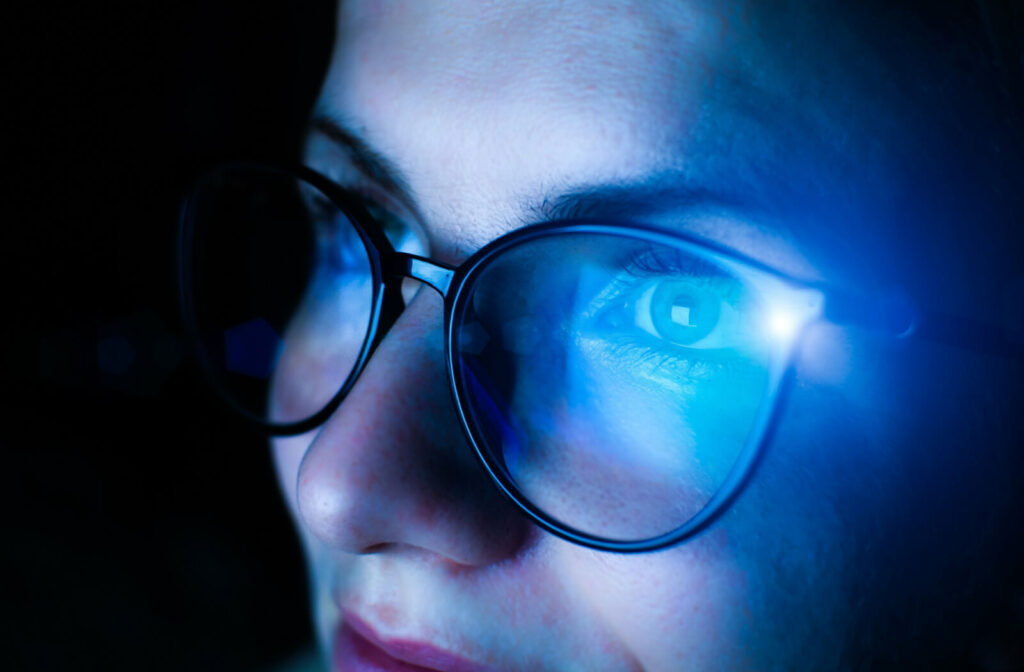It’s hard to escape digital screens when we rely on them for much of our daily lives. From the moment we wake up to the moment we lay our heads to rest, we spend considerable time engaged with digital devices.
While blue light from these screens has taken the blame for many vision-related issues, there is no evidence to suggest this. While blue light glasses can be helpful in some circumstances, they won’t protect against headaches caused by digital eye strain.
If you experience discomfort, headaches, or vision changes after long periods spent in front of digital screens, an eye exam can rule out any underlying eye conditions to safeguard your sight.
What Is Blue Light?
Blue light is a short, high-energy wavelength on the visible light spectrum. It’s predominantly present in natural sunlight but can also be found in artificial light sources like digital screens.
We rely on blue light from the sun to regulate our circadian rhythms—our natural sleep/wake cycle. It also helps boost mood, memory, and cognitive function.
However, the artificial blue light given off by digital screens, especially at night, can suppress melatonin production and disrupt the circadian rhythm, leading to daytime sleepiness and fatigue.
The Role of Blue Light Glasses
Blue light glasses, also known as computer glasses, have gained popularity as a potential solution to alleviate the symptoms of digital eye strain. These glasses have special coatings that reduce the amount of blue light entering the eyes.
While blue light glasses might help some individuals by reducing symptoms associated with prolonged screen time, the best approach is to discuss your concerns with your eye doctor before making an informed decision.
What Is Digital Eye Strain?
Contrary to what people think, it’s not the blue light that gives us headaches when using screens, but how we use digital devices. Our eyes aren’t built for the long hours of focus that these devices demand, which can lead to a range of symptoms known as digital eye strain.
When we stare at screens for extended periods, our eyes have to work extra hard to stay focused and clear. Unlike printed text with sharp edges, digital content is made up of pixels. Our eyes are constantly adjusting to these flickering pixels, which can be taxing on our vision.
This constant focusing and refocusing can lead to eye fatigue and discomfort.
Plus, when we’re engrossed in our screens, we tend to blink less, leading to dry and irritated eyes. And we also sit too close or look at screens from poor angles, adding to the discomfort and strain.
Blue Light Glasses & Headaches
Digital eye strain can lead to a range of symptoms, including:
- Blurry vision
- Double vision
- Dry eyes
- Red eyes
- Irritated eyes
- Tired eyes
- Watery eyes
- Headaches
Headaches associated with digital eye strain are often the result of eye muscle fatigue and an increased workload on the visual system. Looking at screens at a close angle means the eye muscles contract and converge (focus and move the eyes inward to see an image), causing fatigue.
No evidence suggests blue light glasses can reduce symptoms associated with this process. But you can reduce your symptoms by altering your habits when using screens.
How to Prevent Headaches & Digital Eye Strain
Digital eye strain is usually temporary and doesn’t cause long-term issues with your eye health. However, it has similar symptoms to other eye conditions that can cause ongoing problems, so it’s essential to see your optometrist for an accurate diagnosis.
Regular eye exams can help identify refractive errors or other issues contributing to headaches and eye strain. They can also work with you to develop a plan to help you avoid uncomfortable symptoms when working on a computer.
Some strategies you can try yourself include:
- Following the 20-20-20 rule: Give your eyes a break by looking at something 20 feet away for 20 seconds every 20 minutes.
- Blinking more: Infrequent blinking when looking at screens can dry out your eyes. Remember to blink more often to maintain a healthy, lubricated eye surface.
- Using artificial tears: Eye drops can provide some relief from dry eyes. Speak to your eye doctor about which eye drops to use.
- Reducing glare on your screen: Glare can cause eye strain, so adjust the brightness of your screen and the surrounding light to cut back on glare.
- Adjust your workstation for ergonomics: Following recommended ergonomics can help keep you more comfortable overall. Adjust your screen so it’s at or slightly below eye level, and ensure proper posture.
- Managing your screen time: Cutting back on the time you spend on digital devices, especially before bed, can help improve your sleep quality.
Eye Health in the Digital Age
When searching for relief from headaches associated with screen time, it’s crucial to approach your concerns with your complete eye health in mind. Rather than viewing blue light glasses as a single fix, understand them as a tool among many in your toolbox against digital eye strain.Book an appointment with Focus West Optometry for effective solutions tailored to your unique needs.



